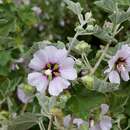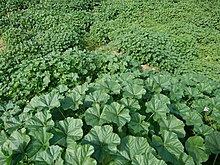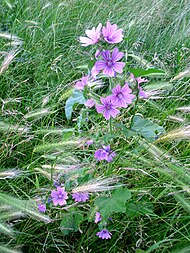Malva is a genus of herbaceous annual, biennial, and perennial plants in the family Malvaceae. It is one of several closely related genera in the family to bear the common English name mallow. The genus is widespread throughout the temperate, subtropical and tropical regions of Africa, Asia and Europe.[3]
The leaves are alternate, palmately lobed. The flowers are from 0.5–5 cm diameter, with five pink, lilac, purple or white petals.
Etymology
The word "mallow" is derived from Old English "mealwe", which was imported from Latin "malva", cognate with Ancient Greek μαλάχη (malakhē) meaning "mallow", both perhaps reflecting a Mediterranean term.[4]
The colour mauve was in 1859 named after the French name for this plant.
Uses
Ornamental plant
Several species are widely grown as garden flowers. Very easily grown, short-lived perennials are often grown as ornamental plants.[5]
Food
Many species are edible as leaf vegetables[5] and commonly foraged in the West. Known as ebegümeci in Turkish, it is used as vegetable in Turkey in various forms such as stuffing the leaves with bulgur or rice or using the boiled leaves as side dish. Malva verticillata (Chinese: 冬寒菜; pinyin: dōngháncài, Korean: 아욱 auk) is grown on a limited commercial scale in China; when made as a herbal infusion, it is used for its colon cleansing properties and as a weight loss supplement.
In the Levant, Malva nicaeensis leaves and fruit are used as food (e.g., khubeza patties).
Mild tasting, young mallow leaves can be a substitute for lettuce, whereas older leaves are better cooked as a leafy green vegetable. The buds and flowers can be used in salads. Small fruits that grow on the plants can also be eaten raw.[5]
Bodos of Northeast India cultivate a subspecies of Malva called lapha and use it extensively in their traditional cuisine, although its use is not much known among other people of India except in the northern Indian state of Kashmir where Malva leaves are a highly cherished vegetable dish. It is called "Soachal".
Medical use
In Catalonia (Spain) they use the leaves to cure the sting or paresthesia of the stinging nettle (Urtica dioica).
Leaves of various species Malva have been used in traditional Austrian medicine internally as tea or externally as baths for treatment of disorders of the skin, gastrointestinal tract and respiratory tract.[6] The leaves can also be chewed to soothe coughs or sore throats.[5]
Cultivation
Cultivation is by sowing the seeds directly outdoors in early spring. The seed is easy to collect, and they will often spread themselves by seed.
Some Malva species are invasive weeds, particularly in the Americas where they are not native.[3]
History
This plant is one of the earliest cited in recorded literature. The third century BC physician Diphilus of Siphnus wrote that "[mallow] juice lubricates the windpipe, nourishes, and is easily digested."[7] Horace mentions it in reference to his own diet, which he describes as very simple: "Me pascunt olivae, / me cichorea levesque malvae" ("As for me, olives, endives, and mallows provide sustenance").[8] Lord Monboddo describes his translation of an ancient epigram that demonstrates Malva was planted upon the graves of the ancients, stemming from the belief that the dead could feed on such perfect plants.[9]
Species
The following species are accepted:[3]
-
Malva acerifolia (Cav.) Alef.
-
Malva × adulterina Wallr.
-
Malva aegyptia L.
-
Malva aethiopica C.J.S.Davis
-
Malva agrigentina (Tineo) Soldano, Banfi & Galasso
-
Malva alcea L. – greater musk-mallow, vervain mallow
-
Malva arborea (L.) Webb & Berthel.
-
Malva × arbosii Sennen
-
Malva assurgentiflora (Kellogg) M.F.Ray – island mallow, mission mallow, royal mallow, island tree mallow
-
Malva bucharica Iljin
-
Malva cachemiriana (Cambess.) Alef.
-
Malva cavanillesiana Raizada
-
Malva × clementii (Cheek) Stace
-
Malva × columbretensis (Juan & M.B.Crespo) Juan & M.B.Crespo
-
Malva cretica Cav.
-
Malva durieui Spach
-
Malva × egarensis Cadevall
-
Malva flava (Desf.) Alef.
-
Malva hispanica L.
-
Malva × inodora Ponert
-
Malva × intermedia Boreau
-
Malva leonardii I.Riedl
-
Malva lindsayi (Moran) M.F.Ray
-
Malva × litoralis Dethard. ex Rchb.
-
Malva longiflora (Boiss. & Reut.) Soldano, Banfi & Galasso
-
Malva ludwigii (L.) Soldano, Banfi & Galasso
-
Malva lusitanica (L.) Valdés
-
Malva maroccana (Batt. & Trab.) Verloove & Lambinon
-
Malva microphylla (Baker f.) Molero & J.M.Monts.
-
Malva moschata L. – musk-mallow
-
Malva multiflora (Cav.) Soldano, Banfi & Galasso
-
Malva neglecta Wallr. – dwarf mallow, buttonweed, cheeseplant, cheeseweed, common mallow, roundleaf mallow
-
Malva nicaeensis All. – French mallow, bull mallow
-
Malva oblongifolia (Boiss.) Soldano, Banfi & Galasso
-
Malva occidentalis (S.Watson) M.F.Ray
-
Malva olbia (L.) Alef.
-
Malva oxyloba Boiss.
-
Malva pacifica M.F.Ray
-
Malva pamiroalaica Iljin
-
Malva parviflora L. – least mallow, cheeseweed, cheeseweed mallow, small-whorl mallow
-
Malva phoenicea (Vent.) Alef.
-
Malva preissiana Miq. – Australian hollyhock
-
Malva punctata (All.) Alef.
-
Malva pusilla Sm. – small mallow
-
Malva qaiseri Abedin
-
Malva setigera K.F.Schimp. & Spenn.
-
Malva stenopetala (Coss. & Durieu ex Batt.) Soldano, Banfi & Galasso
-
Malva stipulacea Cav.
-
Malva subovata (DC.) Molero & J.M.Monts.
-
Malva sylvestris L. – common mallow, high mallow
-
Malva × tetuanensis Pau
-
Malva thuringiaca (L.) Vis.
-
Malva tournefortiana L.
-
Malva trimestris (L.) Salisb.
-
Malva unguiculata (Desf.) Alef.
-
Malva valdesii (Molero & J.M.Monts.) Soldano, Banfi & Galasso
-
Malva verticillata L. – Chinese mallow, cluster mallow
-
Malva vidalii (Pau) Molero & J.M.Monts.
-
Malva waziristanensis Blatt.
-
Malva weinmanniana (Besser ex Rchb.) Conran
-
Malva xizangensis Y.S.Ye, L.Fu & D.X.Duan
References
-
^ "Malva L." Germplasm Resources Information Network. United States Department of Agriculture. 12 March 2007. Archived from the original on 6 May 2009. Retrieved 16 February 2010.
-
^ "Malva L." Index Nominum Genericorum. International Association for Plant Taxonomy. 9 February 1996. Retrieved 9 May 2008.
-
^ a b c d "Malva Tourn. ex L." Plants of the World Online. Board of Trustees of the Royal Botanic Gardens, Kew. 2017. Retrieved 14 June 2021.
-
^ O.E.D (1989) 2nd.ed. vol.IX, p.271 col.3; P.Chantraine, Dictionnaire de la langue grecque, Klincksieck, Paris 1968, vol.2 p.662. The Italian linguist Vincenzo Cocco proposed an etymological link to Georgian malokhi, comparing also Hebrew מַלּוּחַ (malúakh) meaning "salty". Gordon Douglas Young, Mark William Chavalas, Richard E. Averbeck, Kevin L. Danti, (eds.) Crossing boundaries and linking horizons: studies in honor of Michael C. Astour on his 80th birthday, CDL Press, 1997 pp.162-3.
-
^ a b c d Nyerges, Christopher (2016). Foraging Wild Edible Plants of North America: More than 150 Delicious Recipes Using Nature's Edibles. Rowman & Littlefield. p. 100. ISBN 978-1-4930-1499-6.
-
^ Vogl, Sylvia; Picker, Paolo; Mihaly-Bison, Judit; Fakhrudin, Nanang; Atanasov, Atanas G.; Heiss, Elke H.; Wawrosch, Christoph; Reznicek, Gottfried; Dirsch, Verena M.; Saukel, Johannes; Kopp, Brigitte (2013). "Ethnopharmacological in vitro studies on Austria's folk medicine—An unexplored lore in vitro anti-inflammatory activities of 71 Austrian traditional herbal drugs". Journal of Ethnopharmacology. 149 (3): 750–71. doi:10.1016/j.jep.2013.06.007. PMC 3791396. PMID 23770053.
-
^ Soyer, Alexis (1853). The Pantropheon: Or, History of Food and Its Preparation : from the Earliest Ages of the World. Ticknor, Reed, and Fields. p. 64.
-
^ Horace, Odes 31, ver 15, c. 30 BC
-
^ Letter from Monboddo to John Hope, 29 April 1779; reprinted by William Knight 1900 ISBN 1-85506-207-0.




 Malva sylvestris
Malva sylvestris  Cheeseweed, Behbahan, Iran
Cheeseweed, Behbahan, Iran